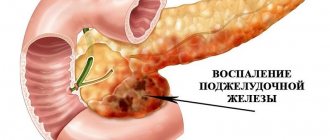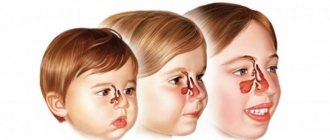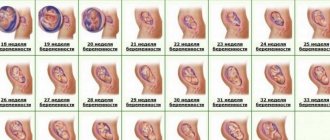What does it mean
It is important to understand that hemoglobin is a special protein that is found inside erythrocytes (red blood cells).
The main feature of hemoglobin is that it can attach oxygen or carbon dioxide to itself. It is hemoglobins and red blood cells that transport oxygen throughout the body - from the lungs to the tissues, then they pick up carbon dioxide in the tissues and carry it to the lungs. Low hemoglobin in an infant means that the tissues do not have enough oxygen.
A reduced level of hemoglobin and a low number of red blood cells in the blood of a newborn is anemia.
Hemoglobin norm for an infant:
- at birth – 140 – 240 g/l;
- newborn (2 – 3 weeks) – 130 – 200 g/l;
- up to 3 months -95 – 145 g/l;
- from 6 months to 5 – 6 years – 110 – 160 g/l (average level 130 g/l).
Causes of anemia in newborns
- Iron deficiency, a decrease in the concentration of red blood cells in the mother’s blood during pregnancy, does not provide the baby with an initial supply of iron;
- premature or complicated pregnancy (impaired blood flow, placental insufficiency, abnormalities in fetal development, etc.);
- pathological birth (trauma, entanglement, umbilical cord clamping, etc.);
- peculiarities of the newborn’s blood circulation (the body’s own hematopoietic system does not meet the body’s needs, a decrease in hemoglobin is possible by 4–5 months of life);
- errors in artificial or mixed feeding (special mixtures are needed, you can’t feed with goat’s milk, much less cow’s milk!);
- poisoning with mercury and other heavy metals;
- hereditary diseases of the stomach and intestines, low iron absorption (gastritis, dysbacteriosis);
- injuries, operations with blood loss;
- allergies, diathesis (forced dietary restrictions);
- lack of folic acid, copper, vitamin C, B 12 interferes with the absorption of iron;
- hormonal imbalances, metabolic disorders.
Important: the nutritional system of vegetarians and veganism always leads to iron deficiency; it is impossible to do without additional iron-containing supplements for a nursing mother and child.
Treatment
For mild first degree anemia, which is less dangerous to the child’s health, a diet with a high iron content is prescribed
For mild first degree anemia, which is less dangerous to the child’s health, a diet with a high iron content is prescribed. For babies who are bottle-fed, special formulas of an adapted type are selected, but children who are breastfed need to consume iron-rich mother's milk. To do this, a nursing mother must eat well and follow a healthy diet, giving up bad habits.
The second degree of anemia involves consuming iron-fortified foods and taking medications. These medications are available in the form of syrups, which are given between feedings of the baby. Milk can block the absorption of iron in the body.
The third degree of anemia is severe, treatment should occur in a hospital setting. Iron preparations are injected into a vein, and the dose is calculated by the doctor, depending on the severity of the child’s condition.
Anemia can cause developmental delays in a child and lead to mental and physical disorders. Therefore, it is necessary to promptly contact a specialist for help.
Hemolytic anemia is more difficult to treat. When making a diagnosis, a blood transfusion will be prescribed, as well as surgery, which involves removing the spleen organ.
Symptoms of anemia in newborns
Warning Signs of Infant Anemia:
- excessive pallor (lips, under nails, palms, mucous membranes);
- lethargy, rapid fatigue of the baby;
- increased sweating;
- irritability, the child is capricious, often cries;
- anxious sleep, restlessness, the baby does not get enough sleep;
- begins to suffer from viral infections frequently;
- wounds may appear in the corners of the lips, stomatitis;
- appetite decreases, the child often burps;
- Possible hair loss.
Symptoms
Anemia most often develops slowly, so its signs can only be noticed after some time has passed. First of all, these include decreased appetite, pale skin, and low muscle tone. The child gets tired faster, sleeps poorly and is more often capricious. The liver may become slightly enlarged, and the stool has a clay-like consistency. The immune system also suffers, as a result of which the child may often suffer from colds.
Unlike other types of disease, Yaksh-Gayem anemia is characterized by a sharp and rapid deterioration in the child’s well-being. The skin is clearly pale, the liver and lymph nodes are significantly enlarged, and the body temperature periodically rises. In some cases, the baby may suffer from shortness of breath.
If you notice one or more of these signs in your infant, contact your pediatrician for a blood test to rule out or confirm the presence of anemia, as well as determine its type and severity.
What is the danger of anemia in infants?
The most important danger is that the tissues are not sufficiently enriched with oxygen, and diseases can develop:
- renal failure;
- enlarged liver, jaundice;
- heart disease (low blood pressure, heavy breathing, shortness of breath, heart murmurs), changes in lymph nodes;
- bowel dysfunction (constipation, diarrhea, constant “grumbling” in the stomach).
In critically advanced cases, anemia leads to a lag in psychophysiological development, leading to deadly consequences (cardiomyopathy, hypoxic coma, etc.).
Treatment of anemia in infants
The main rule in treating neonatal anemia is to prevent its occurrence.
Initially, even before birth, the fetus accumulates iron; these reserves are usually enough for six months of the baby’s life.
It is known that if a woman, while still pregnant, has not provided such a supply for her unborn child, then problems with anemia will begin very early, almost from birth.
Modern laboratories can determine the level of iron reserves in a woman during pregnancy; for this it is necessary to take a test for the protein ferritin. If the expectant mother does not have reserves, then special iron-containing preparations are prescribed so that the baby has time to accumulate iron even before birth.
There is a myth that milk, especially breast milk, naturally increases hemoglobin. It has been scientifically proven that any milk contains very little iron.
When the child is 5-6 months old, he is pale, his palms are pale pink, he needs to donate blood for hemoglobin in order to further determine:
- complementary feeding tactics, that is, replenish the diet with foods containing iron (meat, pomegranates, liver, apples, etc.);
- the need to prescribe special medications for infants - drops, syrups (maltofer, ferrum lek, etc.).
Recommendations:
- from 3 months of age, with mixed feeding, you need to select a special mixture enriched with iron (Nutrilon with iron, Enfamil with iron, etc.);
- exclude semolina porridge from the diet (contrary to myths, it is useless), replace it with buckwheat;
- You can give a six-month-old baby a decoction of rosehip, kiwi, black currant (replenishment of vitamin C).
Important: medications, dosage, duration and method of administration are prescribed only by the attending physician after examining the baby; self-medication is unacceptable!
Causes
Unbalanced and improper nutrition of the woman herself while carrying a baby, and especially a deficiency of much-needed iron in the diet, is one of the causes of the disease.
There are several divisions, the first of which applies to babies in the first months of life, namely up to 12 weeks.
The main factors for the occurrence of iron deficiency anemia in newborns of this age are:
- Unbalanced and improper nutrition of the woman herself while carrying a baby, and especially a deficiency of much-needed iron in the diet. In the final weeks of pregnancy, the level of specific iron-containing protein decreases in most pregnant women. This suggests that it is important to promptly pay attention to test results during pregnancy. To enrich your diet with various foods that contain large amounts of iron, you must take special medications as prescribed by your doctor. A decrease in hemoglobin levels in a pregnant woman affects the development of the fetus inside the womb and can cause hypoxia, that is, oxygen starvation. And it can affect the entire development of the unborn child.
- Infectious factor - is responsible for the presence of various types of infections in the body of a pregnant woman if the mother suffered from some type of infection while carrying a child. They block the normal absorption of iron by the fetus, which leads to iron deficiency.
- Prematurity - almost all babies born prematurely have anemia in the clinical picture. It appears due to the weakened body of the baby. It cannot produce the necessary and required number of red blood cells.
- Unbalanced nutrition during lactation - in babies who have passed the 12 week mark, manifestations of anemia are observed due to improper nutrition of the nursing mother. Iron deficiency anemia occurs in babies who are supplemented or fed with milk formulas specially adapted for children.
- Also, anemia can occur in young children during direct breastfeeding, if the nursing woman does not receive nutrients and large amounts of iron from the diet, and also abuses alcohol and smoking. For young children who may exhibit anemia, there are special adapted milk formulas containing increased amounts of iron.
- Rhesus - conflict - can become a serious cause when anemia occurs. In this case, hemolytic anemia occurs. After the baby is born, the membranes of his red blood cells begin to break down, and hemoglobin is gradually destroyed. Anemia of this type can be caused by the penetration of infection into the fetus inside the womb by herpes viruses, rubella or toxoplasma. Pregnant women should be under the watchful supervision of a specialist during the period of bearing a child.
- Blood loss is the cause of anemia in the first year of life. This occurs due to large blood losses during and after childbirth. Hemorrhages are also possible during pregnancy. In addition, the occurrence of anemia is influenced by incorrect and late constriction of the umbilical cord, incorrect structure of the umbilical cord or placental site. This type of anemia can be hereditary, and in this case the culprit is a gene that begins to provoke a change in the formation of red blood cells. This type of disease can affect the formation of the baby’s skull, its deformation, and be responsible for the vault of the palate and the special shape of the nasal septum.
Types of anemia in children under one year old
There are many types of anemia, the most common are:
- Acute and chronic anemia associated with blood loss (injuries, frequent nosebleeds).
- Iron-deficiency anemia. The bone marrow cannot synthesize red blood cells (the bone marrow needs certain vitamins and iron to synthesize red blood cells); due to iron deficiency, hemoglobin is not produced in sufficient quantities.
- Hemolytic anemia is the destruction of red blood cells under the influence of poisons and toxins.
Iron deficiency anemia is most common in infants.
Symptoms of iron deficiency anemia
The first symptoms of iron deficiency anemia are general weakness and fatigue.
General weakness comes to the fore among complaints with the development of anemic syndrome in patients. With long-term iron deficiency, the functioning of all organs and systems, including the brain, suffers, so children often complain of fatigue, become drowsy and irritable. Often there are flashing spots before the eyes, loss of consciousness, headache, and numbness of the limbs.
In advanced cases of the disease, shortness of breath appears even with minimal physical exertion, appetite worsens or its perversion occurs: the use of substances that do not have nutritional value (chalk, earth, metal objects).
When examining a child, you can reveal pale and dry skin, cracks in the corners of the mouth, smoothness of the papillae of the tongue, striations and defects on the nail plates. A mild degree of iron deficiency is manifested by rapid fatigue, headache, memory impairment, decreased academic performance in schoolchildren and decreased immunity.










